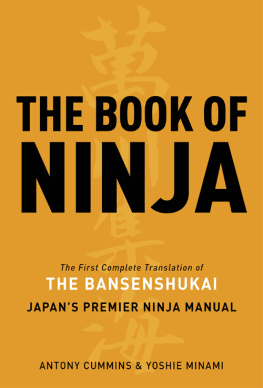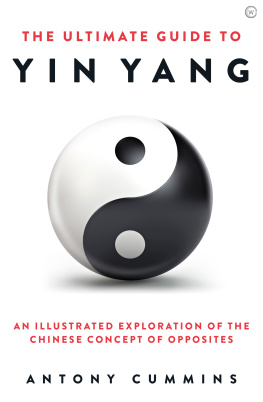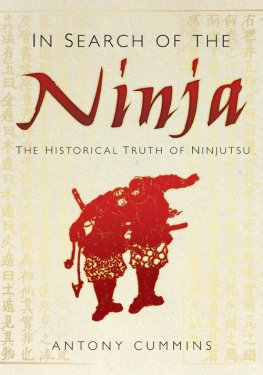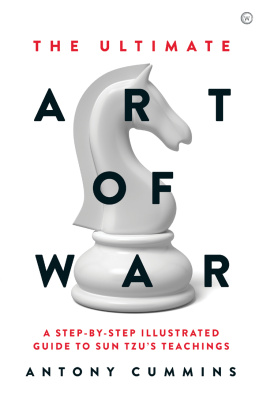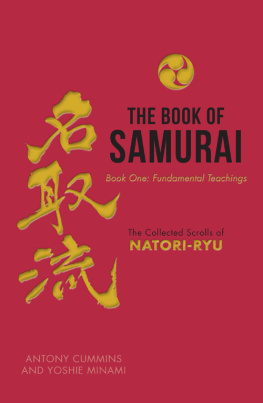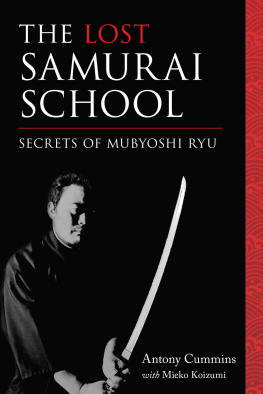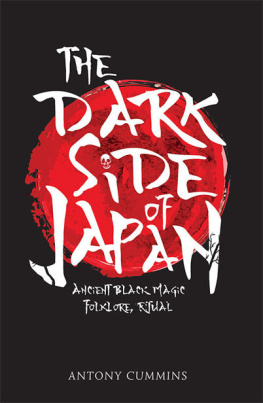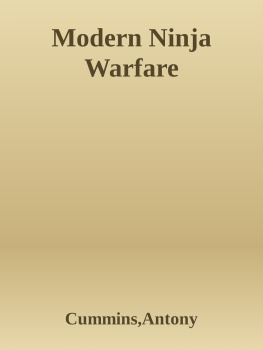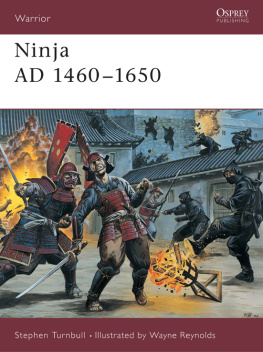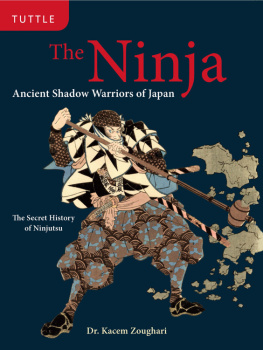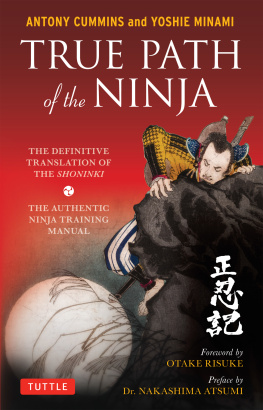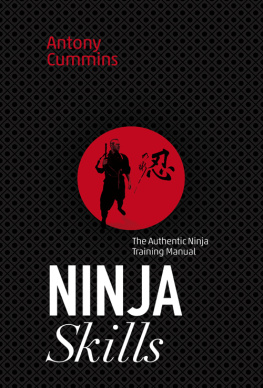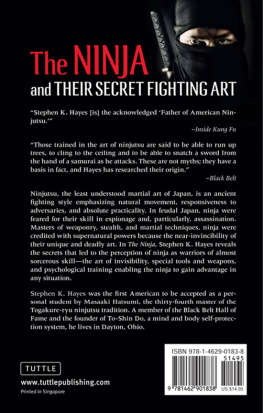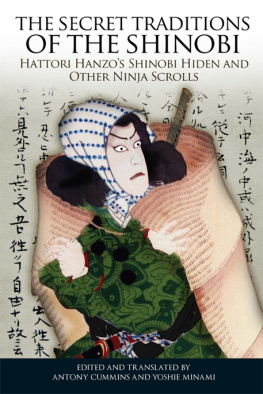THE BOOK OF
NINJA
The First Complete Translation of
THE BANSENSHUKAI
JAPANS PREMIER NINJA MANUAL
ANTONY CUMMINS & YOSHIE MINAMI
READER WARNING
The Bansenshukai is a Japanese military manual based on samurai guerrilla tactics, espionage, assassination and destruction, which contains dangerous and deadly information. Instructions include: theft, explosives, poisonous gases, toxins, clandestine and underhanded action and arson, among many other military topics. This translation has been made available in English for the purpose of history and for education and is a deep and academic look into the misunderstood arts of the Japanese shinobi no mono, or ninja as they are more commonly known. Therefore, the information contained within is for research purposes only and should not be recreated nor re-enacted in any way.
DEDICATION
We should remember that within these pages is the combined knowledge of generations of men who fought in forgotten wars and confrontations, who were unknown, faceless and who died, not on the front lines, but way beyond its borders. We must also remember that while the shinobi have become iconic in our world, they were once real people who were caught up in the horrible reality that is war, a practice humans still cling to even in our enlightened society. These men of Iga and Koka should be collectively remembered, as while they were part of that world, they pushed the conventional limits and went beyond the required norm and perfected themselves on the darker path of clandestine warfare. Thus, we should take their teachings and forge them into positive ways for future generations, taking their seed of perfection and detailed thinking, making the shinobi of tomorrow individuals who can fathom the logical outcomes of todays decisions and who can help make those decisions count, for the benefit of everyone.
SPECIAL THANKS
A special thank you must go to members who have helped with the pursuit of and the interpretation of this manual. Firstly and most importantly to Steven Nojiri, who has become a corner stone of the Historical Ninjutsu Research Team and whose knowledge on Japanese locks, history, politics and subtleties is profound. Secondly, to Dr Nakashima Atsumi, whose avid research into the lives of the people of Koka and Iga is helping to rediscover and respect the ways of the untold numbers of faceless combatants from the past and to all the family members and friends who have understood our need to drag ancient writings into this modern age. Lastly, a thank you to our editor, James Hodgson, for his phenomenal effort in bringing this script to life and to Rebecca and Deborah at Watkins for all their hard work.
Foreword
by
Dr Nakashima Atsumi
First of all I would like to express my sincere admiration to Mr Antony Cummins and Ms Yoshie Minami, who have translated the Bansenshukai and introduced it to the English-speaking world. Therefore, to appreciate their devoted work, I am going to comment on how this publication has been realized and also on the outline of the Bansenshukai manual itself.
Antony came here to Japan, from the other side of the world, from the distant land of England, and has travelled around this country of Japan with Ms Minami conducting thorough research. Through these travels, we came to be known to each other due to the fact that I have previously published a commentary on the Shoninki ninja manual and other books on the subject of ninjutsu. The first time we met, I realized that they were amazingly passionate and strongly determined to publish the English translation of my Shoninki and then to follow up with the Bansenshukai too, which moved me so deeply and in truth left me feeling a little envious.
Of the numerous ninjutsu scrolls, the Bansenshukai is profound, and is the largest compiled volume of information from the ninjutsu schools of both Iga and Koka, which were considered the lands of the ninja. Fortunately, compared to the Shoninki which I believe is a real masterpiece the text of the Bansenshukai is straightforward and self-explanatory. In addition, it is also fortunate that the transcription kept in the National Archives is written in a style comparatively close to modern Japanese and can be read and understood by those who are not so familiar with old writings, which is a great advantage. Therefore, it is possible to convey to people what is written within without making many serious mistakes. However, in order to achieve a complete interpretation of the text, as there are so many places in its pages which have deeper connotations and are difficult to understand in a profound way, even a discourse of three thousand pages would not be enough to make a perfect explanation of all the meanings within and it would take many years of study to truly explain every detail. This is because hidden within the meaning of the text is the masses of knowledge that was made up of kuden or oral tradition, which now, unfortunately, has been lost.
Generally, when defined in short, ninjutsu is a set of arts, including: life skills, espionage, sabotage, murder, military science, divination, astrology, astronomy, magic, various kinds of observation skills, and any other skills people needed to survive and achieve their aims. These might also include the martial arts, for a ninja would have to train himself in arts such as jujutsu grappling, kenjutsu swordsmanship, archery and horse riding etc. Also, there are many other skills required by the ninja, but they are too extensive and various to mention here. Manuscripts on ninjutsu have only the simplest mention of general skills of living or astrological skills and the arts of astronomy, and assume that the reader should well understand these things. In particular, they have no mention of swordsmanship, horse-riding skills or other combat skills, because it was taken for granted that people would naturally train themselves in those areas. Other general skills that the ninja learned are left not in ninjutsu manuals but in other forms. For example, in the Umasugi clan of Koka, they have passed down a menkyo certificate for the horse-riding skills of the otsubo ryu in their family, meaning that simply looking at just the ninja scrolls limits our understanding of the full range of skills in which shinobi would have been proficient.
Most writings on ninjutsu have only simplified information, and where it needs detailed explanations, they would not write down everything but simply say kuden, which means passed down in oral traditions. Therefore, to interpret those manuscripts, you need a great deal of capability. In other words, it depends on your level of comprehension as to whether you feel that the Bansenshukai is marvellous or it is not.
Even with the titanic work of the Bansenshukai, if you were a ninja, you would not be able to fully understand everything at once. Therefore, please take your time and try to read between the lines and with patience.
A number of transcriptions of the Bansenshukai have been left and, as they were all transcribed by hand and not mechanically, no two transcriptions are completely identical. I myself have interpreted four versions of the manual, which are different from each other, some having missing parts, some adding supplementary sections, or even omitting that which the transcriber thought was unnecessary, etc.

